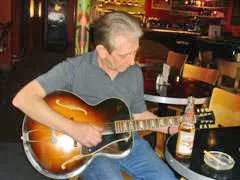Very Basic 12-Bar Blues Progression Lesson
Very basic explanation of the 12-bar blues progression in the key of A (using A, D and E chords). Then into simple variations like the 'shuffle' and then using a few simple substitution chords. (See lesson text in 'Lyrics' section.)
This is to go with text and tab I've done for the most basic use of the 12-bar blues progression in the key of A.
Story behind the song
This was made to go with a post I made at the GTU web-site a few years ago in order to explain it a little more fully. (Lesson text in "Lyrics" section.)
Lyrics
The text of that post...
My Posts To Blues Rhythms
One of the most common uses of the I-IV-V progression is in the construction
of a 12-bar blues (whether used as a blues or a rock'n'roll or whatever).
The most common form of the 12-bar blues progression
(and there are several) is:
I (A) = Four bars
IV (D) = Two bars
I (A) = Two bars
V (E) = One bar
IV (D) = One bar
I (A) = Two bars
A 12-bar blues is often shown as being 7th chords but it rarely is.
You may choose to use one or more 7ths, but generally it is not only or
always 7ths being used. Major or mostly major chords is more common.
Next to a simple beat on the major or power-chord in time with the rhythm,
the next most complex (and probably most popular) beat is the "shuffle".
The shuffle can be done very simply or more complexly, depending on
skill and just how you want it to sound. (Keep in mind that just because
a guitarist doesn't want complexity in a given tune, it doesn't mean he
has a low skill level. He may just want simplicity for a reason). A
shuffle, in its simplest form, is alternately adding and omitting a
6th note in time with the rhythm. For example, an A-chord (or partial A)
held like this X02220, X0222X or X022XX. If you hold those strings down
with your first finger, you can alternately add and omit the 6th note (F#)
like this (use 2 short half-beats each figure):
X0222X
X0422X
X0222X
X0422X
The same can be done to the IV chord (D X00232) like
this (again, two half-beats each):
X00232
X00432
X00232
X00432
And the V chord (E 022100 or 022XXX):
022XXX
042XXX
022XXX
042XXX
Each one of those groups above is ONE BAR
(4 beats) of a common 12-bar blues.Think of
a bar as "One-and-Two-and-Three-and-Four-and..."
(8 half-beats=4 beats)
X0222X =One
X0222X=and
X0422X =Two
X0422X=and
X0222X=Three
X0222X=and
X0422X=Four
X0422X=and
That's one bar....
A complete 12-bar progression is:
I (A) = Four bars
IV (D) = Two bars
I (A) = Two bars
V (E) = One bar
IV (D) = One bar
I (A) = Two bars
And that's a twelve bar blues shuffle in its simplest form. Often the
last bar of the twelve is walked into the V (E) position. This is known
as a "turnaround" and leads into the next 12-bar verse. This simplest 12-bar
shuffle can be advanced one more step by also adding the (flat) 7th note to
the "shuffle" like this (2 beats each):
X022XX (2 beats)
X042XX (2 beats
X052XX (2 beats)
X042XX (2 beats)
(repeat, etc)
(That above was one bar, I position, of a 12-bar blues rhythm.)
An so on in the same way through all the other chords. I chose a 12-bar
in A for an example because it can be shown with all open chords at the
nut. This same "shuffle" figure can easily be done anywhere on the neck
in any key by using barre-chords in the common E-barre or A-barre shape,
and then alternately adding the 6th/7th notes to it. I apologize if this
first example of a blues rhythm is too simple for some people reading this,
but I've often found guitarists that could burn out some mixolydian lead
or something who didn't understand the concept of a 12-bar shuffle, the
seminal basis of blues and rock'n'roll (like Chuck Berry ). A great example
of this shuffle, with a few rhythm-embellishments that I'll explain later
when I have a little more time (I'm at work), is the Led Zepplin cover of
the old Sonny Boy Williamson tune "Bring It On Home". Anyway, I hope this
helps a little.
******************************************************
Now I'll "up-grade" that shuffle another step. If you've listened to
Bring It On Home you'll notice a few bassy-sounding walk-in notes added
to that shuffle. In the key of A, adding them to that shuffle I posted
on the previous page, you could play it like this:
X022XX (2 beats)
X3XXXX (1 beat)
X4XXXX (1 beat)
X022XX (2 beats)
X042XX (1 beat)
X022

